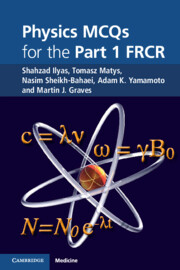Book contents
- Frontmatter
- Contents
- Preface
- Acknowledgements
- 1 Basic physics
- 2 Radiation hazards and protection
- 3 Imaging with X-rays
- 4 Film-screen radiography
- 5 Digital radiography
- 6 Fluoroscopy and mammography
- 7 Nuclear medicine
- 8 Computed tomography
- 9 Imaging with ultrasound
- 10 Magnetic resonance imaging
- Bibliography
- Index
2 - Radiation hazards and protection
Published online by Cambridge University Press: 05 July 2011
- Frontmatter
- Contents
- Preface
- Acknowledgements
- 1 Basic physics
- 2 Radiation hazards and protection
- 3 Imaging with X-rays
- 4 Film-screen radiography
- 5 Digital radiography
- 6 Fluoroscopy and mammography
- 7 Nuclear medicine
- 8 Computed tomography
- 9 Imaging with ultrasound
- 10 Magnetic resonance imaging
- Bibliography
- Index
Summary
Concerning radiation damage to tissues, which of the following are correct?
It is caused directly by photoelectrons
Cells with high mitotic rates are less affected
It is caused by free radicals
Secondary electrons cause damage to tissue in a linear pattern
It is caused directly by X-rays
Which of the following are true regarding dosimetry?
Kerma takes into account the type of tissue being irradiated
The absorbed dose is measured in grays (Gy)
The equivalent dose takes into account the radiation weighting factor (wR)
The effective dose is measured in Gy
1 Gy = 1 J g−1
Regarding radiation dose:
Linear energy transfer (LET) is the total energy deposited by a particle along its entire path
An alpha particle has a lower LET than an electron
Particles with high LET are more hazardous than low-LET particles
The effective dose takes into account the radiosensitivity of the tissues
1 Sv = 1 J kg−1
Which of the following are correct regarding deterministic effects of radiation?
It has a minimum threshold below which it does not occur
The severity of the effect increases with dose
The probability of the effect occurring increases with dose
Breast cancer is a type of deterministic effect
[…]
- Type
- Chapter
- Information
- Physics MCQs for the Part 1 FRCR , pp. 15 - 27Publisher: Cambridge University PressPrint publication year: 2011



